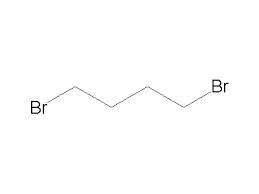About 1 4- डिबà¥à¤°à¥à¤®à¥à¤¬à¥à¤¯à¥à¤à¥à¤¨
| Name of Product | 1-4 Dibromobutane |
| CAS No | 110-52-1 |
| Formula | C4H8Br2 |
| IUPAC Name | 1,4-dibromobutane |
| InChI | InChI=1S/C4H8Br2/c5-3-1-2-4-6/h1-4H2 |
| InChI Key | ULTHEAFYOOPTTB-UHFFFAOYSA-N |
| Canonical SMILES | C(CCBr)CBr |
| EC Number | 203-775-5 |
| UNII | G49PHR6JFU |
| Description | Clear, colourless to yellowish red liquid |
| Water | Not more than 0.1 % |
| Acidity | Not more than 0.1% |
| Purity by GC | Not less than 98.0 % |
| Other name / synonyms | 1,4-DIBROMOBUTANE |
| 110-52-1 |
| Tetramethylene dibromide |
| Butane, 1,4-dibromo- |
| Tetramethylene Bromide |
| 1,4-Dibrombutan |
| 1,4-Butylene bromide |
| Tetramethylenebromide |
| 1,4-dibromo-butane |
| alpha,omega-Dibromobutane |
| 1,4-Dibrombutan [German] |
| CCRIS 8917 |
| ULTHEAFYOOPTTB-UHFFFAOYSA-N |
| EINECS 203-775-5 |
| NSC 71435 |
| DBB |
| BRN 1071199 |
| AI3-14617 |
| 1,4dibromobutane |
| 1,4-dibromobutan |
| 1,4 dibromobutane |
| 1.4-dibromobutane |
| Butane,4-dibromo- |
| 1, 4-dibromobutane |
| 1,4 -dibromobutane |
| 1,4-dibromo butane |
| Dibromo-1,4 butane |
| PubChem3870 |
| 1, 4-dibromo-butane |
| 1,4-dibromo-n-butane |
| BrCH2CH2CH2CH2Br |
| UNII-G49PHR6JFU |
| 1,4-bis(bromanyl)butane |
| G49PHR6JFU |
| AC1L1Q5X |
| AC1Q27UB |
| SCHEMBL8484 |
| WLN: E4E |
| DSSTox_CID_24364 |
| DSSTox_RID_80172 |
| NCIOpen2_003230 |
| DSSTox_GSID_44364 |
| KSC176S6R |
| 140805_ALDRICH |
| 1,4-BUTYLENE DIBROMIDE |
| CHEMBL3185714 |
| CTK0H6968 |
| MolPort-000-153-861 |
| BB_SC-6730 |
| KST-1B6721 |
| LABOTEST-BB LTBB001556 |
| ACMC-209969 |
| NSC71435 |
| Tox21_301070 |
| ANW-16159 |
| AR-1B7690 |
| BBL027293 |
| NSC-71435 |
| SBB060204 |
| STL280306 |
| AKOS000118763 |
| AS03526 |
| LS40910 |
| MCULE-5088378536 |
| RP26939 |
| RTC-030979 |
| TRA0067784 |
| NCGC00248278-01 |
| NCGC00254971-01 |
| AK-47721 |
| AN-43005 |
| BC201066 |
| BP-21423 |
| BR-47721 |
| CAS-110-52-1 |
| KB-10556 |
| LS-45685 |
| SC-00339 |
| ST2408478 |
| TC-030979 |
| AM20080049 |
| D0176 |
| FT-0606854 |
| ST51046434 |
| 51369-EP2272826A1 |
| 51369-EP2272843A1 |
| 51369-EP2272848A1 |
| 51369-EP2275404A1 |
| 51369-EP2281817A1 |
| 51369-EP2311824A1 |
| 4-01-00-00267 (Beilstein Handbook Reference) |
| A802208 |
| 3B4-2833 |
| I14-4996 |
| InChI=1/C4H8Br2/c5-3-1-2-4-6/h1-4H |
Versatile Applications in Synthesis1,4-Dibromobutane serves as a crucial intermediate for pharmaceutical and agrochemical manufacturing, as well as a crosslinking agent in organic synthesis. Its well-defined structure and high purity make it highly desirable in research and industrial applications. This substance effectively aids in the formation of various complex compounds, enhancing the efficiency and specificity of synthetic processes.
Safety and Storage RecommendationsTo maintain optimal stability, 1,4-Dibromobutane should be stored in its original, unopened bottle in a cool, dry, and well-ventilated location, away from direct sunlight and ignition sources. It is harmful if inhaled or ingested, and can irritate skin and eyes. Strict adherence to storage guidelines and use of appropriate personal protective equipment is essential to ensure safe handling.
Packaging and Transport StandardsThis product is available in customized packaging or standard sizes (250 ml, 500 ml, 1 L glass bottles) to meet diverse requirements. Transported under the UN 2687 code and classified as Hazard Class 6.1, it complies with global regulations for toxic chemicals. Shelf life extends up to 24 months under recommended storage conditions, ensuring consistent quality during transit and storage.
FAQs of 1 4- Dibromobutane:
Q: How should 1,4-Dibromobutane be stored for maximum stability?
A: Store 1,4-Dibromobutane in a tightly closed glass bottle in a cool, dry, and well-ventilated area, away from sources of ignition, direct sunlight, and moisture to preserve its stability for up to 24 months.
Q: What is the primary use of 1,4-Dibromobutane in industry and research?
A: 1,4-Dibromobutane is primarily employed as a chemical intermediate in pharmaceutical synthesis, organic synthesis, and as a crosslinking agent. Its high purity and defined properties make it valuable for both laboratory research and industrial applications.
Q: When is 1,4-Dibromobutane considered hazardous and what safety measures are recommended?
A: It is classified as a toxic substance (Hazard Class 6.1) and is harmful if inhaled or ingested, as well as irritating to skin and eyes. Appropriate safety gear, including gloves and eye protection, should be worn, and handling should occur in a well-ventilated setting.
Q: Where is 1,4-Dibromobutane commonly transported and under what regulations?
A: This compound is exported globally, commonly from manufacturing hubs such as India. It is shipped under UN Number 2687, meets Hazard Class 6.1 requirements, and follows international norms for transporting toxic substances.
Q: What packaging options are available for 1,4-Dibromobutane purchases?
A: 1,4-Dibromobutane can be supplied in 250 ml, 500 ml, or 1 L glass bottles, with customized packaging available to suit specific requirements, facilitating safe handling and transportation.
Q: How is 1,4-Dibromobutane used in pharmaceutical and agrochemical synthesis?
A: In these sectors, 1,4-Dibromobutane acts as a building block in the synthesis of active compounds and as a crosslinking agent, aiding in the development of new molecules and materials vital to medical and agricultural innovations.
Q: What are the benefits of using high purity (98%) 1,4-Dibromobutane in synthesis?
A: Using 98% pure 1,4-Dibromobutane ensures greater product yield, minimizes unwanted byproducts, and supports consistent, reliable outcomes in both research and commercial-scale chemical synthesis.

